It’s a good thing that more CO detectors are showing up on the aviation market because pilots may never give carbon monoxide in the cabin the consideration it deserves. Even I had an eye-opening moment flying home from AirVenture last summer in a friend’s well-maintained Cessna and found my Aithre Shield portable monitor registering 40 ppm of CO in the cabin.
If you still don’t fly with a CO detector, this article of our top-pick new products (to supplement our portable CO detector roundup article in the April 2022 Aviation Consumer) is for you.
CARBON MONXIDE 101
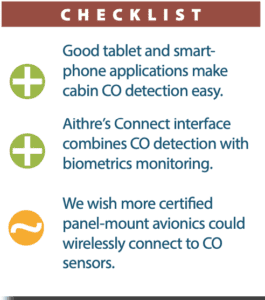
The lethal gas is generated by engines as a byproduct of the combustion process. In a well-maintained aircraft, CO is exhausted out of the engine compartment, and breathing it reduces your body’s ability to carry oxygen in your blood. At some point you’ve perhaps felt the symptoms—fatigue, headaches, shortness of breath and impaired motor functions. At higher altitudes, CO poisoning symptoms include dizziness, chest pain, poor vision and difficulty thinking. Extended exposure to high levels of CO means death. Breathing supplemental oxygen will help—but not eliminate—the impacts of CO poisoning.
Relying on a chemical-based CO detector (the Dead Stop product comes to mind) might not be a failsafe plan. It requires that the pilot or passengers have sufficient cognitive skills to see that the color has changed and recognize that CO poisoning is imminent. In our view, an audio-integrated CO detector is perhaps the ultimate attention-getter to help break the cognitive skill gap caused by CO. Fortunately they exist, and several manufacturers have put sizable focus on CO detection and warning for the GA cockpit with new products. For this follow-up, we’ll concentrate on models from Aithre, Guardian, Sensorcon, Lightspeed and ForeFlight, which can interface wirelessly.
New to the scene are headset and ADS-B manufacturers who have added CO sensors to their products, and wireless capability has taken CO detection to a higher level.
AITHRE
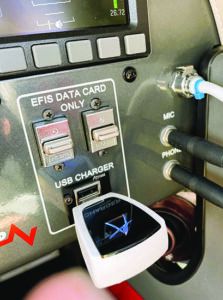
We’ve reported extensively on Aithre Aviation’s connected ecosystem, which puts a sharp focus on hypoxia, oxygen flow and cockpit biometrics. At the center of the tech is the free Aithre Connect smartphone app, plus growing integration into experimental avionics including the Garmin G3X Touch, Dynon SkyView and Advanced Flight Systems displays. There is no interface with Garmin’s certified displays.
We think Aithre’s biometrics products are well-engineered with a medical-grade feel. Aithre Shield is the company’s line of CO detectors, and include the first USB stick CO sensor, and there are install-approved (under the FAA’s NORSEE rules) and experimental panel integrated solutions. All the Shield CO detectors work with the Aithre Connect app, which is supported on iOS and Apple Watch. There are no plans to build an Android version, and we asked founder Jim Ruttler why. He says the architecture is more complex than it may seem.
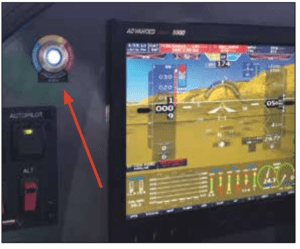
“Our Aithre Connect app appears simple on its face, but has an immense and ever-growing web of complexity behind the scenes to manage the Aithre network of devices. Because of this network complexity, we have elected to focus all our efforts on one platform to make sure we have the safest health technology possible,” he told us. That leaves Android users out of an otherwise useful safety backstop.
With continuous monitoring of cabin CO and multi-passenger oxygen saturation (through the Illyrian Smart Oximeter), the Connect app allows for early warning indicators of health issues to cabin dwellers. The app has a variety of pop-up notifications for CO (2 ppm, 10 ppm, 50 ppm or custom-set ppm levels), as we’ll as hours of trend information—including plots of CO vs. temperature, airspeed and altitude. On the pulse oximeter, the app provides default warning levels of 92 percent and 85 percent SpO2 as we’ll as a custom level, with trend information for up to six passengers.
The notifications come in as Siri voice and pop-up chimes to a paired aviation headset or audio panel. Any of the biometric and carbon monoxide data can be set up to automatically flow oxygen from Aithre’s smart oxygen system; think of it as an autopilot for health.
We’ve heard from potential buyers that Aithre’s Shield CO sensor line is tough to navigate, and that’s partly because of early-gen products—proving that Aithre is improving the product. Here’s a rundown.
Aithre Shield encompasses five products (four permanently installed sensors and one portable). Based upon the same underlying technology, EX 1.0 (discontinued), EX 2.0, EX 3.0, Shield Portable 4.0/6.0 and eDOT 5.0 deliver similar functionality at different prices.
The $300 EX 2.0 and $400 EX 3.0 are intended for uncertified aircraft and vary based upon the sensor’s CO sensitivity. For comparison, the older EX 1.0 is a 30-second sensor with response between 10 and 255 ppm with +/-15 percent accuracy, but the newer ones have responses between 0 and 255 ppm with 1 ppm resolution. Installation of the Shield is as simple as connecting power, ground and serial data wiring to compatible displays for SpO2, CO and oxygen tank display (model specific).
The $400 model EX 3.0 acts as a bridge to glass panels with low-energy Bluetooth wireless connectivity to the Illyrian SpO2 and Meso (oxygen tank) sensors. It works with the Dynon SkyView and Garmin experimental G3X displays. The eDOT includes a panel-mounted LED annunciator.
The $450 eDOT 5.0 is designed for installation in Part 23 non-pressurized certified aircraft, using the FAA NORSEE process. Every Aithre CO detector is individually calibrated (a signed certificate is included)using high-precision calibration CO gas and has a 10-year recertification interval.
The Shield Portable 4.0 with rechargeable battery has been replaced by the Shield Portable 6.0, but Aithre says there are still a bunch of 4.0s in distribution (Aircraft Spruce had inventory at press time, selling them for $150). The current Shield 6.0 has changes based upon lessons learned over the model 4.0’s five-year run. Released at AirVenture last summer, it has a smaller footprint and it’s designed to work with any Bluetooth-enabled aviation headset to provide a robust set of Siri notifications, including crossing 2 ppm, 10 ppm, 50 ppm and user-selected ppm levels. There is also trend graphing for CO over time versus pressure altitude, cabin temperature and airspeed to identify relationships between these values and a real-deal CO emergency. Additionally, there are three trips stored in history on the app and all trips are logged directly on the Files app of the iOS device as a comma-separated file for use with any spreadsheet for graphing or review. The device itself has a glowing indicator that is blue, amber or red and this can be set in the app to pulse or steady modes. There is no built-in speaker because their customers did not find that the speakers were easy to hear over the aircraft engine and opted to use any Bluetooth enabled headset for clear noise-free speech notifications and alerts. There is no built-in battery, just a USB-A port. The kit comes with a female to male USB-A extension cable and two mounting clips. You can power Shield 6.0 with a USB power vault or panel-mounted USB power source.
Aithre has been able to navigate supply chain issues because the company makes and bakes the electronics in-house. It has been able to pivot to new component suppliers and continue production and delivery without delay in any oxygen or health technology products. It sells direct from its website (www.aithreaviation.com) and through suppliers including Sporty’s and Aircraft Spruce, to name two. The products have a one-year warranty.
GUARDIAN AVIONICS
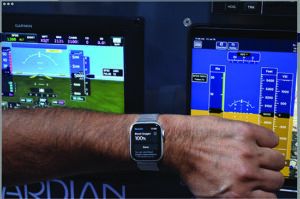
After company founder Ash Vij had a CO emergency in a Cessna, Guardian began manufacturing carbon monoxide sensors in 1999 and has more than 20,000 sensors in GA aircraft. Cessna, Diamond and Cirrus have included Guardian Aero 452 CO sensors as standard equipment since 2006, fully integrated into the Garmin G1000 stack.
Guardian has a portable CO detector as we’ll as detectors for certified (45x and 55x lineup) and experimental/homebuilt aircraft (35x lineup). The Aero 452 CO detectors are designed to be panel mounted or mounted behind the panel. The remote-mount CO detectors support remote LED alerts. Guardian’s CO detectors for certified aircraft have models that are certified under NORSEE (e.g., 451-101 priced at $448) or TSO certified (e.g., 452-101 priced at $548). Based upon the specifics of your aircraft, you might consider contacting Guardian directly to determine which model would be best suited for your aircraft. CO detector pricing ranges from $348 to $749, plus any accessories.
Guardian’s TSO’d Aero line of detectors incorporate sensitive CO sensors and will begin alerting at 50 parts per million. Aero can alert three different ways: an 85-dB audio tone, a light and an audio tone delivered through the audio panel. It will alarm if the CO level exceeds 50-70 ppm for more than five minutes and will provide an instant alarm if CO spikes above 300 ppm within one minute. That provides ample time for the pilot to ventilate and land at the closest practical airport. A number of Aero models are equipped with a built-in pressure sensor, providing an alert as the aircraft climbs through 10,000, 12,500 and 14,000 feet, reminding aircrew and passengers to don supplemental oxygen.
Guardian has wrapped their CO alerting technology into a variety of form factors, panel-mounted and remote. The remote sensor supports panel-mounted light, audio panel connectivity and integration into a variety of PFDs, MFDs, GPS radios and engine analyzers. With a standard RS-232 connector, wiring is straightforward. Average installation time can be between one to two hours.
The Aero 553 is intended to replace an existing chronometer and includes timing and monitoring functions such as clock, flight timer, stopwatch, inside/outside air temperatures, battery voltage, cabin altitude and density altitude. Guardian’s Aero 553 CO alarm will activate after the following ppm values: 10 to 50, display only, no alarm; 50 to 70, 4-minute alarm mode; 70 to 100, 3-minute alarm mode; 200, 2-minute alarm mode; 300, 1-minute alarm mode; and greater than 400, 14-second alarm mode. The Aero 553 has a yellow/red LED that is coupled to an 85-dB audio alarm. The 553 can also be integrated into the aircraft’s audio panel, generating four short beeps. When CO is detected between 50 to 100 ppm, the LED will be yellow and the CO Alert page on the 553 will be displayed, showing the quantity of CO. The alert message will stay on until the CO level reduces to below 50 ppm. A red LED illumination indicates that CO is greater than 100 ppm. Guardian panel-mounted CO detectors also support a panel-mounted remote LED indicator as we’ll as integration into a variety of multi-function displays (MFDs) like Garmin and Dynon.
The Aero 553 has an output that is compatible with RS-232 and can interface with a GNS 480, Garmin G1000, G9000, Electronic Instruments EI-50 and some experimental MFDs. See Guardian’s website for current capabilities installed on your aircraft. The CO level, inside air temp and outside air temp are transmitted by the Aero 553 to the MFD once every second. Depending on the MFD software capabilities, the unit will display CO level, cabin temperature, cabin pressure and outside air temperature.
The Guardian devices require CO sensor servicing every five or seven years, depending upon the specific model. Essentially, the CO sensing technology must be replaced. Aircraft owners have the option of ordering a factory-overhauled replacement and then swapping out their original unit and returning it for a $100 USD core value. A typical factory recalibrated Aero starts at $448, based upon the model. You can purchase Guardian CO detectors directly from their website. Interestingly, Aircraft Spruce sells Guardian CO detectors for more than the manufacturer. An Aero 553 from Aircraft Spruce is $885 while Guardian retails the Aero 553 for $748. A variety of accessories are available for Guardian detectors including an OAT probe, panel-mounted CO alert indicator, wiring harnesses and crimp connector kits. Guardian products have a one-year warranty.
Guardian has been working on a new CO detector (Aero 454 for certified aircraft and Aero 354 for uncertified aircraft), which includes Bluetooth and an app. The new product is undergoing the FAA’s certification process; however, Guardian expects their new products to be available in time for Sun ‘n Fun. The new Bluetooth-enabled CO detectors will leverage Guardian’s smartMFD app for iOS, which is a key component to Guardian’s smartPlane system. The app can be used with just the new CO detectors and will provide data logging of all of the data created in the CO detectors. Interestingly, smartMFD integrates with Apple’s Watch, pulling health data from the SpO2, heart rate and cardiac sensors integrated into Watch (model dependent).
The smartMFD app also provides CO level alerts and pulse oximeter readings (when connected to a smartLink 555). While smartMFD is a free download from the App Store, which unlocks more features and functionality, Guardian is contemplating an annual subscription fee, but has no firm costs in mind. Guardian’s smartMFD app has a ton of functionality too, and we’ll look at it in a separate article. Contact www.guardianavionics.com.
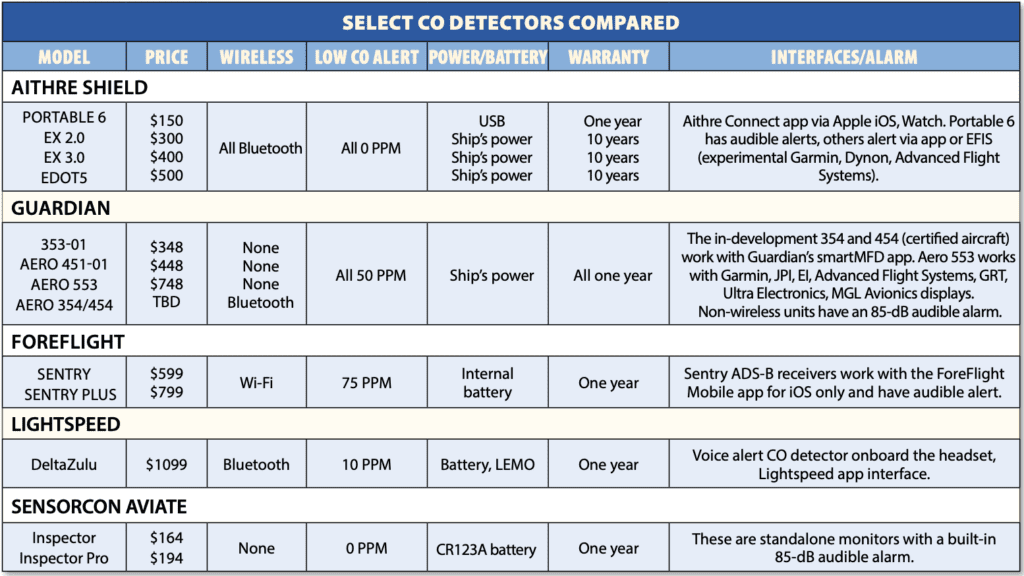
SENSORCON
A subsidiary of Molex (an 80-year-old company driving innovation in electronics, supporting industries from automotive to healthcare and consumer to data communications), Sensorcon manufactures two portable CO detectors for aviation, and has been manufacturing gas detection sensors and has sold more than 50,000 devices. The first Inspector model CO detector was released in 2011.
The $164 AV8 Inspector and the $194 AV8 Inspector Pro are about the size of a large cellphone, and there is an option to mount it on the panel. It’s easy to take with you and the devices include a lanyard, belt clip and a removable mount that uses the belt clip. The AV8s are programmable to specific personal limits (Pro model only), will generate an audible and vibration alert (Pro model) and track CO exposure levels over a 24-hour period. Sensitivity is as low as 0 ppm to a high of 500 ppm. The Pro model with its vibrating and adjustable alarm has a 24-hour time-weighted average. Both models have preset alarms at 35 ppm and 200 ppm. Alarms include a visual LCD/LED and an audible 80- to 85-dB buzzer. Both models include a MAX mode, which calculates the maximum amount of CO exposure at any given time. This is a very useful feature, as CO binds itself to your hemoglobin and it can take many days for the CO to be expelled from your body.
The AV8 CO detectors are powered by a CR123A battery with an expected two-year life, and the device’s display has a low-battery indicator. The life expectancy of the AV8 CO sensors is five years (perhaps longer with care) and Sensorcon says they will operate for two years without any sensor recal. When shipped, the AV8 detectors are calibrated and tested to read within +/-10% of the calibration gas applied (+/- 5 ppm). Over time, the electrochemical sensor in the detector will drift. Sensorcon estimates that their sensors drift approximately 10 percent every six months. For the best accuracy, Sensorcon recommends calibrating the sensor every six months. With this in mind, you may choose to adopt a different calibration schedule. Some pilots opt to calibrate the detector every two years. Sensorcon offers a calibration service, but you can do it yourself. The cost to have Sensorcon calibrate your AV8 detector is $49 (plus shipping and taxes) and requires you to ship it back to their location in Buffalo, New York. You can buy a calibration kit from Sensorcon for $254, which includes a gas regulator, tygon tubing and 50 ppm CO calibration gas.
The AV8’s feature set is simple; simply hold the Power/Mute button for one or two seconds to turn the detector on. It will display a 10-second countdown timer while the sensor warms up before displaying real-time readings.
We like that the device serves double duty in the air and on the ground as a CO diagnostic tool, and the owner’s manual has a useful CO exposure chart that shows the physiological impacts as the CO ppm raises, including the maximum time-weighted average exposure for an eight-hour workday (25 ppm). It’s a great reminder of the perils of CO exposure. At press time the company was offering a 20 percent discount to pilots (code AV820) when buying online at www.sensorcon.com.
FOREFLIGHT, LIGHTSPEED
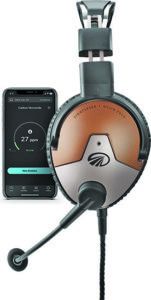
We covered the ForeFlight Sentry and Sentry Plus portable ADS-B receivers in the January 2023 Aviation Consumer and the Lightspeed Delta Zulu ANR headset in the November 2022 issue. All of these devices have built-in CO monitors. To recap, first the Delta Zulu.
Lightspeed’s Kanari smart alert technology (think Canary in a coal mine) is built into the headset and provides an audible warning (directly in the headphone audio). The Lightspeed app (iOS only) will display the CO sensor data and provide a full history through data recording and this is also used to customize the CO alerts and thresholds. The CO sensor in the headset has a 10-year life span and will be replaced by Lightspeed for a nominal fee.
The headset checks the CO sensor every time that it is powered on. If there is a problem with the CO sensor, the headset will generate an audible warning—“Carbon Monoxide Not Monitored”—and there will be a visual error shown in the Lightspeed app. The sensor does not require recalibration by the factory—convenient, in our view. The CO sensor has a +/- 2 ppm drift rate over its 10-year life span, suggesting that it’s rather accurate.
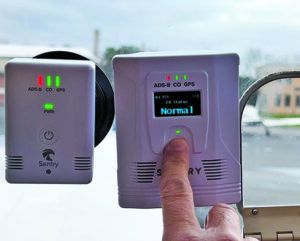
You can tell the amount of CO by a single press on the multifunction button on the headset’s control box. After the initial calculation period, the single press action will report the CO value to you. For example, with no CO present, it will say “Carbon Monoxide Normal, zero PPM.” The CO sensor will not operate if the headset’s batteries are dead. If you’re an Android user, you can have a flying buddy set up the alerts using their Apple iOS device. While airborne, you do not need the app to receive CO alerts. But it’s nice to see the quantity of CO in real time. We would like to see Lightspeed add a cumulative CO exposure factor in its app.
Both ForeFlight’s $599 Sentry and $799 Sentry Plus receivers are manufactured by uAvionix, and the CO feature is straightforward. The devices have three LEDs, and the middle LED is the CO status: green for normal (less than 75 ppm), yellow for caution (75 to 200 ppm) and red for danger (greater than 200 ppm). With ForeFlight running on an iOS device, a pop-up will occur when Sentry or Sentry Plus detects CO: “Caution, Sentry CO level is 80 ppm.” The CO sensor’s actual sensitivity is greater than the green, yellow and red values. As well, an audible alert will be played over the iOS device’s speakers as we’ll as the Sentry and Sentry Plus itself (over 90dB) when more than 200 ppm of CO is detected. ForeFlight can change the CO alerting through future firmware updates, and we would prefer to see green as less than 5 ppm, yellow as 5 to 40 ppm and red as greater than 40 ppm. Perhaps the company can eventually allow users to set custom CO alerting levels.
The audible alarm can be muted by pressing the Sentry’s power button and tapping the pop-up alert in ForeFlight. The tap to hide in ForeFlight will hide the alert for five minutes. For testing purposes, the CO alarm can be triggered via the “Test CO Alarm” button on the Device Status page of ForeFlight.
ALL WORTHY DEVICES
While chemical-based CO detectors are cheap as borscht and require nothing more than changing them out every year or 18 months, we think they’re impractical with the impaired cognitive skills that tag along with deeper levels of CO poisoning. Having a piece of hardware that flashes, beeps, screen pops, vibrates or activates your smartwatch takes CO alerting to a practical level, especially if you set the alerts at a low CO level, like 10 ppm.
We like Aithre’s inexpensive Shield Portable CO device, and favor all of the Aithre products because of the Connect app’s ability to display, alert and trend large amounts of useful biometric data.
Lightspeed’s Delta Zulu and ForeFlight’s Sentry units, with onboard sensors, make it stone simple to keep tabs on cabin CO. We’ll keep watching this growing market and report back as new products emerge.





